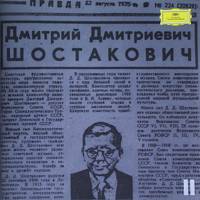|

INDELIBLE VISIONS
OF A TROUBLED WORLD

BILL NEWMAN discusses the Emersons' new recording
of the complete Shostakovich works for string quartet
<< Continued from page 5
Quartet No.11 (1966) in six movements is subtitled 'The Little Theatre
of Dmitri Shostakovich.' It exploits film score, opera and ballet, all of
which he had already delved into, and includes cross fades, double exposures,
titled movements like 'Scherzo', 'Etude', 'Humoresque' [listen,
CD 4 track 7, 0:35 - 1:01], 'Elegy', and a quote from Beethoven's 'Eroica'
Symphony. Finckel again: 'Sometimes, he will repeat something over and over
again. After a while you realize that this isn't meant to be serious, this
is meant to seem ridiculous.' Quartet No.12 (1968) has been described as
dialectic, a succession of smooth-flowing material dissolving into new contrasting
rhythms, becoming redefined, then finally erased. The second movement over
a space of nearly 20 minutes embraces scherzo, adagio and finale, featuring
12 note pitches, violent trills, a 5-note rhythmic figure, stark contrasts
and a re-examination of all that has taken place [listen,
CD 4 track 11, 0:00 - 0:54].
 Between 1970-3, we go beyond reality into the hallucinatory
regions of the unknown. Shostakovich was very ill on drugs for a polio-like
syndrome, and a heart disease that eventually developed into cancer. I am
reminded of an old Picture Post magazine that reproduced the older
Stravinsky's facial expression directing his own music. The photographer
had deliberately blurred his subject to focus solely on the eyes suggesting
that what lay behind the startling façade would stimulate the viewer
into pinpointing the exact moment of inspiration directly springing from
the brain cells. Substitute instead Shostakovich listening spellbound to
a performance of his 15th Quartet, Leningrad, 1974 - the photo appears in
a group adjacent to pages 142/3 in 'Testament' - and you gain insight into
the complexities of his uncanny landscape displayed in the last three Quartets.
No.13 (1970, 3 sections played continuously, dedicated to Vadim Borovsky,
retired violist of the Beethovens) defies convention with wood knockings,
scraping, plucking, thick clotted chords that banish harmony, ghost-like
imaginings [listen, CD 4 track 12, 6:47 - 7:31].
No. 14 (1972-3, 3 movements, cellist Shirinsky once more) isolates its dedicatee,
concentrating on his adept lightness of hand movements [listen,
CD 5 track 1, 1:18 - 2:17]. A sense of timelessness counters earlier
frustrations with ultimate sweet melancholy, but in the final quartet No.15
(1974), solitary notes are wrenched from a background of silence during
the opening Elegy - like Nomads in the Desert - then developed fugue-wise
before subsiding into the key of C major. In the remaining movements - Serenade,
Intermezzo, Nocturne, Funeral March [listen, CD 5
track 8, 0:00 - 1:10], Epilogue - past episodes of the bombings with
their bleak aftermath and the suppressed violence and bitterness of life's
memories find an outlet in a funeral march that parallels Beethoven's A
flat Piano Sonata, Op.26 with its same identical key and rhythmic pulse.
The final section is, in fact an apotheosis of all that went before, the
spirit leaving the body on a fluttering major-minor viola trill linking
hope with despair. Between 1970-3, we go beyond reality into the hallucinatory
regions of the unknown. Shostakovich was very ill on drugs for a polio-like
syndrome, and a heart disease that eventually developed into cancer. I am
reminded of an old Picture Post magazine that reproduced the older
Stravinsky's facial expression directing his own music. The photographer
had deliberately blurred his subject to focus solely on the eyes suggesting
that what lay behind the startling façade would stimulate the viewer
into pinpointing the exact moment of inspiration directly springing from
the brain cells. Substitute instead Shostakovich listening spellbound to
a performance of his 15th Quartet, Leningrad, 1974 - the photo appears in
a group adjacent to pages 142/3 in 'Testament' - and you gain insight into
the complexities of his uncanny landscape displayed in the last three Quartets.
No.13 (1970, 3 sections played continuously, dedicated to Vadim Borovsky,
retired violist of the Beethovens) defies convention with wood knockings,
scraping, plucking, thick clotted chords that banish harmony, ghost-like
imaginings [listen, CD 4 track 12, 6:47 - 7:31].
No. 14 (1972-3, 3 movements, cellist Shirinsky once more) isolates its dedicatee,
concentrating on his adept lightness of hand movements [listen,
CD 5 track 1, 1:18 - 2:17]. A sense of timelessness counters earlier
frustrations with ultimate sweet melancholy, but in the final quartet No.15
(1974), solitary notes are wrenched from a background of silence during
the opening Elegy - like Nomads in the Desert - then developed fugue-wise
before subsiding into the key of C major. In the remaining movements - Serenade,
Intermezzo, Nocturne, Funeral March [listen, CD 5
track 8, 0:00 - 1:10], Epilogue - past episodes of the bombings with
their bleak aftermath and the suppressed violence and bitterness of life's
memories find an outlet in a funeral march that parallels Beethoven's A
flat Piano Sonata, Op.26 with its same identical key and rhythmic pulse.
The final section is, in fact an apotheosis of all that went before, the
spirit leaving the body on a fluttering major-minor viola trill linking
hope with despair.
Continue >>
Copyright © 28 May 2000 Bill Newman,
Edgware, UK
 PURCHASE THIS DISC FROM AMAZON
PURCHASE FROM CROTCHET
CD INFORMATION - DEUTSCHE GRAMMOPHON 463
284-2
BILL NEWMAN IN CONVERSATION WITH THE EMERSON
QUARTET
<< Music
& Vision home Frank Martin >>
PURCHASE THIS DISC FROM AMAZON
PURCHASE FROM CROTCHET
CD INFORMATION - DEUTSCHE GRAMMOPHON 463
284-2
BILL NEWMAN IN CONVERSATION WITH THE EMERSON
QUARTET
<< Music
& Vision home Frank Martin >>
 |
To listen to the aural illustrations in this review,
you may need to download RealNetworks' realplayer G2. |
|